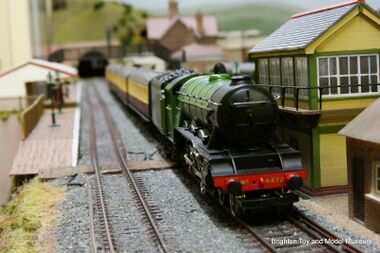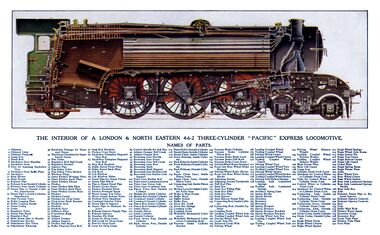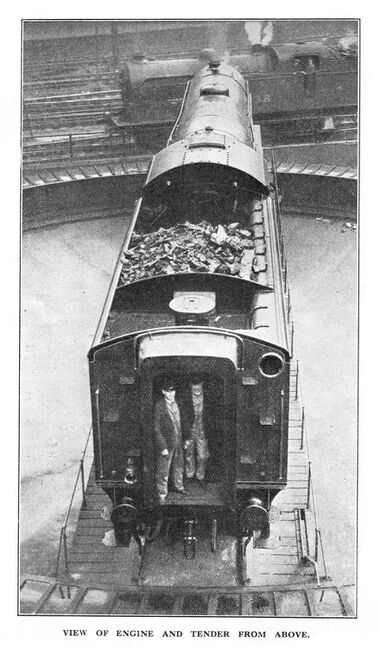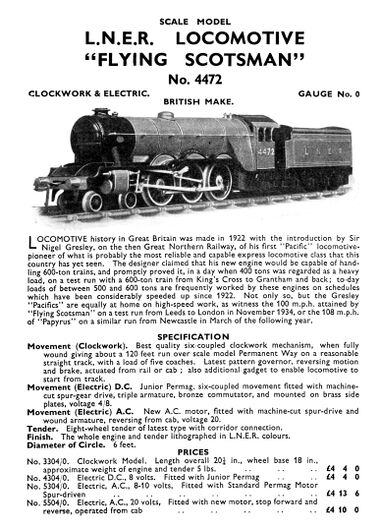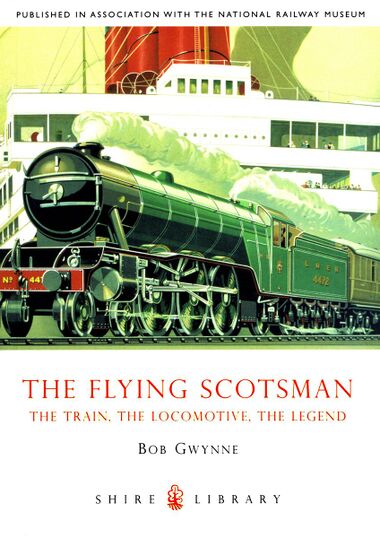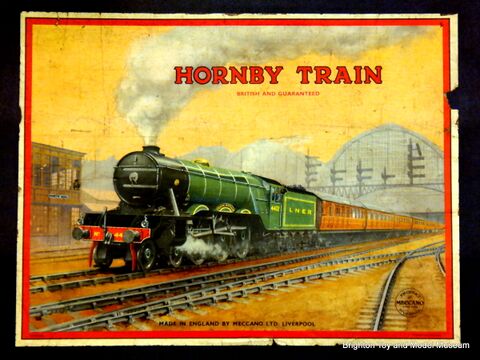Category:Flying Scotsman (locomotive): Difference between revisions
(sentence moved from later in the article to the intro) |
(reworked section on corridor tenders) |
||
| Line 4: | Line 4: | ||
{{Box|Flying_Scotsman_locomotive,_cross-section_(WBoR_14ed).jpg|Cutaway diagram of the Flying Scotsman's locomotive class, with parts list|380}} | {{Box|Flying_Scotsman_locomotive,_cross-section_(WBoR_14ed).jpg|Cutaway diagram of the Flying Scotsman's locomotive class, with parts list|380}} | ||
{{Box|Flying_Scotsman_LNER_4472_with_new_tender_(TRM_1928-05).jpg|1928: LNER 4472 Flying Scotsman with new corridor tender|380}} | {{Box|Flying_Scotsman_LNER_4472_with_new_tender_(TRM_1928-05).jpg|1928: LNER 4472 Flying Scotsman with new corridor tender|380}} | ||
{{Box|Flying_Scotsman_corridor_tender,_rear_view_(TRM_1928-05).jpg|Aerial view of the Scotsman's corridor tender, seen from the rear. The small circle on the right is the window|380}} | |||
{{Box|The_Wonder_Book_of_Railways,_14th_edition,_cover.jpg|View from the cab, front cover of "The Wonder Book of Railways", ''circa'' ~1928(?)|380}} | {{Box|The_Wonder_Book_of_Railways,_14th_edition,_cover.jpg|View from the cab, front cover of "The Wonder Book of Railways", ''circa'' ~1928(?)|380}} | ||
{{Box|Bassett-Lowke,_Flying_Scotsman,_gauge_0_(BL-MR_1937-11).jpg|Bassett-Lowke ''Flying Scotsman'' model, 1937|380}} | {{Box|Bassett-Lowke,_Flying_Scotsman,_gauge_0_(BL-MR_1937-11).jpg|Bassett-Lowke ''Flying Scotsman'' model, 1937|380}} | ||
| Line 16: | Line 17: | ||
The locomotive was a darling of the LNER's publicity department, and was exhibited at the '''1924 and 1925 [[British Empire Exhibition]]s''', where it was displayed alongside "Castle-class" locomotives from [[GWR]]. | The locomotive was a darling of the LNER's publicity department, and was exhibited at the '''1924 and 1925 [[British Empire Exhibition]]s''', where it was displayed alongside "Castle-class" locomotives from [[GWR]]. | ||
== | ==1928: non-stop service and corridor tenders== | ||
The LNER publicity department got a "second bite of the cherry" in 1928 with regards to the Scotsman by relaunching the train service as a new non-stop service, without the stop-off for lunch along the route that was originally part of the schedule. | |||
Since it was impractical to expect a single driver and fireman to stay alert and shovel coal for the entire trip without a break, the new service was only made possible by the construction of a new type of tender to be attached to the engine, which, as well as carrying an extra ton of coal, contained a concealed tunnel that let first- and second-shift crews swap places without stopping the train. The engine-facing end of the tender had a small hatch over this tunnel-corridor, which ran inside the right-hand side of the tender, then had a 90-degree turn leading to a central concertina-style connector that linked to the front of the third-class carriage at the front of the train. Daylight entered the corridor from a small round window at the back of the tender, so as not to spoil the symmetrical appearance of the tender sides. | |||
These innovative corridor tenders were also used with some other LNER express passenger locomotives such as the [[A4]]s, and were instrumental in making the Scotsman's Australian tour feasable. | |||
==1969: The US Tour== | ==1969: The US Tour== | ||
Revision as of 16:14, 26 March 2016
Flying Scotsman 4472 locomotive nameplate (artwork) [image info]
A Hornby Flying Scotsman on the museum's 00-gauge layout [image info]
LNER 4472 Flying Scotsman, photo published in the mid-1930s [image info]
Cutaway diagram of the Flying Scotsman's locomotive class, with parts list [image info]
1928: LNER 4472 Flying Scotsman with new corridor tender [image info]
Aerial view of the Scotsman's corridor tender, seen from the rear. The small circle on the right is the window [image info]
View from the cab, front cover of "The Wonder Book of Railways", circa ~1928(?) [image info]
Bassett-Lowke Flying Scotsman model, 1937 [image info]
The Flying Scotsman is one of Britain's most famous steam locomotives, and was a favourite with toy manufacturers. It's usually depicted with LNER running number 4472, and green paintwork. It was named after the famous Flying Scotman express train service.
The Scotsman set speed records, ran a special London-to-Edinburgh trip during the last year of general steam on the British Railways network, and then went on tour in the US and Australia, where it logged the longest noted non-stop steam train journey. It's the last surviving member of the Gresley 4-6-2 A1/A3 "Pacific" locomotives, and it currently resides in the National Railway Museum.
1924: launch and public showings
The LNER's "The Flying Scotsman" locomotive (running number 4472), was named in 1924. Construction was originally started by the Great Northern Railway (GNR), with the loco being completed in 1923.
The locomotive was a darling of the LNER's publicity department, and was exhibited at the 1924 and 1925 British Empire Exhibitions, where it was displayed alongside "Castle-class" locomotives from GWR.
1928: non-stop service and corridor tenders
The LNER publicity department got a "second bite of the cherry" in 1928 with regards to the Scotsman by relaunching the train service as a new non-stop service, without the stop-off for lunch along the route that was originally part of the schedule.
Since it was impractical to expect a single driver and fireman to stay alert and shovel coal for the entire trip without a break, the new service was only made possible by the construction of a new type of tender to be attached to the engine, which, as well as carrying an extra ton of coal, contained a concealed tunnel that let first- and second-shift crews swap places without stopping the train. The engine-facing end of the tender had a small hatch over this tunnel-corridor, which ran inside the right-hand side of the tender, then had a 90-degree turn leading to a central concertina-style connector that linked to the front of the third-class carriage at the front of the train. Daylight entered the corridor from a small round window at the back of the tender, so as not to spoil the symmetrical appearance of the tender sides.
These innovative corridor tenders were also used with some other LNER express passenger locomotives such as the A4s, and were instrumental in making the Scotsman's Australian tour feasable.
1969: The US Tour
The North American tour of The Flying Scotsman would take it 3500 miles from its home in Britain before starting its 15400 mile-long journey, taking it across much of America and even as far as Canada. The tour was originally a mission of goodwill to promote trade and cooperation between British and American businesses with attention drawn to British exports to the States. It also allowed the organisers to display the pride felt with the ongoing restoration of such a famous locomotive. The American Southern Railways System and its president played official hosts to the Scotsman while it travelled across their railways and assisted in organising parts of the tour that took the locomotive to the networks of other US railway companies. With the American recipients of the Scotsman and the British government participating in and backing the venture, the tour gained much excitement and momentum from both countries.
As well as its ongoing restoration, the locomotive itself underwent several modifications, to ensure its compliance with the Federal Railroads Administrations regulations on locomotives. Many of these were in regard to the difference between the safety rules of Britain and America. The most noticeable of these modifications were the addition of a "cowcatcher", an additional bell, and an American-style whistle. Additional safety modifications included an airbrake system and a high intensity headlamp.
The Flying Scotsman departed from Liverpool docks on September 19th 1969 for a ten-day voyage to Boston. Upon its arrival the Scotsman was greeted with the sound of traditional Scottish bagpipes and was unloaded by US Navy cranes and equipment. The Scotsman's first voyage in America would be from Boston, Massachusetts to Hartford, Connecticut. The rest of the 1969 season would take the locomotive to New York, Washington and Dallas. 1969 proved to be a popular season as the public were described as "waiting in scores" to watch the locomotive pass by, at one point including a whole class of school children who were dismissed early to allow them to view the Scotsman passing by. The following year the Scotsman would visit Texas, Wisconsin and Montreal which was expected to be as popular a season as the last. Although the 1970 season was hit with financial difficulties it still went ahead, with the Scotsman visiting many locations and drawing crowds of the public. 1971 marked the last journeys of the Scotsman through Northern America where it travelled from Toronto, Canada to San Francisco.
At this point the tour was no longer considered financially viable and The Flying Scotsman was put into storage in until 1973 when it was returned to the UK via the Panama Canal to be further restored.
Museum models
As well as conventional commercial locomotive models and toys of the Flying Scotsman, the Museum also had a large 2.5-scale model on display in a glass case upstairs in Brighton Station, set into the glass wall of the ticket office before the station's renovations circa 2013.
See also:
External links
- About the Flying Scotsman, National Railway Museum (nrm.org.uk)
- The engine: Why is Flying Scotsman famous? (ingenious.org.uk)
- Full steam ahead as Flying Scotsman set to return to mainline by end of 2015 (theguardian.com)
- Restoration photos - August 2015 (nrm.org.uk)
- Damning Flying Scotsman report issued by National Railway Museum, April 2013 (rail.co.uk)
Subcategories
This category has only the following subcategory.
F
Pages in category ‘Flying Scotsman (locomotive)’
The following 11 pages are in this category, out of 11 total.
F
- Flying Scotsman (Train Running Day)
- Flying Scotsman 4472 locomotive, steam-powered (Märklin)
- Flying Scotsman locomotive 4472 (2.5" gauge)
- Flying Scotsman locomotive biscuit tin LNER 4472 (Crawfords Biscuits)
- Flying Scotsman locomotive, gauge 0, BR 60103 (Corgi Bassett-Lowke)
- Flying Scotsman locomotive, gauge 0, LNER 4472 (Bassett-Lowke)
- Flying Scotsman No3 locomotive 4472 (Hornby Series)
- Flying Scotsman presentation set 4-344 (Trix Twin Railways)
Media in category ‘Flying Scotsman (locomotive)’
The following 36 files are in this category, out of 36 total.
- Bassett-Lowke advert Royal Scot Flying Scotsman.jpg 2,492 × 1,602; 334 KB
- Bassett-Lowke trains and boats (MM 1934-06).jpg 775 × 1,024; 162 KB
- Bassett-Lowke, Flying Scotsman, gauge 0 (BL-MR 1937-11).jpg 1,545 × 2,152; 562 KB
- Bassett-Lowke, Flying Scotsman, gauge 0 components (BL-MR 1937-11).jpg 2,544 × 1,644; 522 KB
- Bassett-Lowke, Flying Scotsman, gauge 0 components list (BL-MR 1937-11).jpg 1,597 × 2,485; 739 KB
- Bowman Loco 234.jpg 1,086 × 672; 103 KB
- BR 60103 Flying Scotsman (BLCat0-00 1954).jpg 1,155 × 1,600; 419 KB
- Flying Scotsman 4472 at signalbox, 00-gauge layout.jpg 3,200 × 2,134; 3.61 MB
- Flying Scotsman 4472 at signalbox, low angle.jpg 3,200 × 2,134; 3.54 MB
- Flying Scotsman BR 60103 (BLCat 1952-autumn).jpg 3,000 × 1,987; 1.26 MB
- Flying Scotsman corridor tender, cab view (TRM 1928-05).jpg 999 × 1,200; 329 KB
- Flying Scotsman corridor tender, rear view (TRM 1928-05).jpg 1,171 × 2,000; 896 KB
- Flying Scotsman corridor tender, through view (TRM 1928-05).jpg 908 × 1,800; 588 KB
- Flying Scotsman LNER 4472 (WBoR 14ed).jpg 2,500 × 1,959; 1.16 MB
- Flying Scotsman LNER 4472 biscuit tin, Crawfords, detail.jpg 2,500 × 1,409; 1.73 MB
- Flying Scotsman LNER 4472 biscuit tin, Crawfords, tender detail.jpg 2,500 × 1,667; 2.14 MB
- Flying Scotsman LNER 4472 with new tender (TRM 1928-05).jpg 4,337 × 1,265; 1.13 MB
- Flying Scotsman locomotive, card model (Trix1800 SC3).jpg 1,585 × 764; 560 KB
- Flying Scotsman locomotive, cross-section (WBoR 14ed).jpg 3,000 × 1,855; 2.33 MB
- Flying Scotsman nameplate artwork.jpg 1,200 × 459; 68 KB
- Flying Scotsman non-stop service (TRM 1928-05).jpg 777 × 1,200; 295 KB
- Flying Scotsman Train Running Day (2015).png 1,920 × 1,081; 219 KB
- Flying Scotsman Train Running Day, BTMM October 2015.jpg 2,500 × 1,407; 1.82 MB
- Flying Scotsman with bus.jpg 1,600 × 900; 965 KB
- Flying Scotsman, article (MM 1928-04).jpg 1,200 × 798; 600 KB
- Hornby E320 Locomotive, LNER 4472 Flying Scotsman (HBoT 1934).jpg 2,001 × 1,293; 396 KB
- Hornby M0 Locomotive 4472 (HBoT 1930).jpg 2,824 × 1,481; 539 KB
- Hornby Trains, Flying Scotsman 4472 box artwork, rectangular sticker (Meccano Ltd).jpg 2,400 × 1,798; 3.02 MB
- Hornby Trains, Flying Scotsman 4472 box artwork, round sticker (Meccano Ltd).jpg 2,400 × 1,796; 3.5 MB
- Locomotive LNER 4472 Flying Scotsman, gauge 0 (Bassett-Lowke).jpg 1,024 × 768; 414 KB
- Model Locomotive Building, Bassett-Lowke.jpg 1,600 × 534; 251 KB
- The Flying Scotsman, Bob Gwynne, 0747807701 (Shire Library).jpg 848 × 1,200; 168 KB
- The Wonder Book of Railways, 14th edition, cover.jpg 921 × 1,200; 322 KB
- Three New Hornby Trains, Hornby No.3 locomotives (MM 1927-12).jpg 929 × 1,200; 527 KB
- Tri-ang Hornby Book of Trains, cover.jpg 1,543 × 2,200; 697 KB

